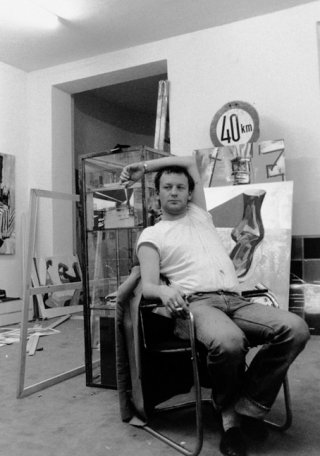
“Big show.” A retrospective look upon the artist’s career appears to be a reckless amalgamation of several different artists from across the twentieth century. We see neo-expressionism, pop art, surrealism, and traces of Dada. Paintings that I would guess to be Kirchner’s, posters that look like they are advertising a Euro-pop band’s 1982 tour, pictures that look like propaganda commissioned by the Soviet government- strewn up on walls with a loose sense of order and little regard for chronology. Without previous knowledge of the exhibition, a displayed introduction or the title plaques next to the individual works, the exhibition would come off as a very impressive private collection or the aimless attempt of a figurehead curator to display half a dozen unrelated artists. But because we know the perspective is one artist’s, comprised only of his career’s output, as one wanders across the MoMA’s sixth floor, they are likely to be stunned by the sheer mass of Martin Kippenberger’s body of work.
His retrospective really is enough to span a life three times as long as Kippenberger’s. The wide variety of work and the actual amount (nearly a thousand pieces) seem to be the basis of the title “A Problem Perspective”, as gaining some kind of artistically themed perspective is impossible. Yet the overlying theme of his work is in its social commentary. His life was themed. Kippenberger was a drunk and a prankster, a deviant, an unabashed rockstar, a notorious troublemaker. His critics spoke in unison. He was “the ultimate poseur, just a court jester with a fabulous instinct for profit”. He was never fully accepted into the art world, and at the same time an icon. Martin Kippenberger: A Problem. 
And so we walk through A Problem Perspective armed with two constants. One is a smile. Whether a sign of quality or not, Kippenberger was a funny guy. His work is funny. The “shameless exhibitionism” and self-promotion in his posters is universally flippant. Sculptures like “Capri at Night” (1982) (Ford’s affordable take on a European sports car, rolled in oats, painted and signed) and “Stand in the Corner and be Ashamed of Yourself” (1990) are, if not laugh-out-loud funny, at least amusing. His alter-ego, Freddy the Frog was a muppet-esque character, except he was drunk and most famously portrayed nailed to the cross. In passing, this is a funny visual, but reflection reminds us that mockery is offensive. Freddy the Frog was not only self-deprecating but also alludes to the artists crucifixion, and maybe even martyrdom, presumably in the art world. (I suppose it should be mentioned that Pope Benedict XVI condemned this piece in 2008. ) And even with less blatant works like the aforementioned “Capri at Night”, Kippenberger is taking shots at a peer as the sculpture was a “droll riff on the highly serious brown paintings embedded with straw by Anselm Kiefer.” We might be laughing at Kippenberger’s work, but at points we are laughing as a response to confrontational audacity.
And so we walk through A Problem Perspective armed with two constants. One is a smile. The second is a perception of stylistic inconsistency. If you move counter clockwise through the exhibit, the second room of installation- and the first opportunity to see Kippenberger’s art in a traditional medium- shows paintings from the series ‘Dear Painter, Paint For Me’. Technically speaking, these may very well be ‘Kippenberger’s’ best pieces, because the heavy-handed artist commissioned somebody else to paint them. I don’t even know how that makes me feel. Are these really ‘Kippenberger’s Works’? How come I can’t even find the commissioned artist’s name? Otherwise his paintings are rather crude. One critic even stated that his paintings "offend [. . .] every kind of good, bad, and indifferent taste." 
Although many academics associate Kippenberger with a post-modern Dadaism or post-modern pop art, if anything at all, I see a quintessentially German style in Kippenberger’s brush work. His ‘ugly’ style seems akin to neo-expressionists such as Baselitz and Kiefer. “Likable Communist Woman” (1983) reminds of Max Beckman. “The Mother of Joseph Beuys” (1984) screams Ernst Ludwig Kirchner. This is particularly interesting because there was an ongoing feud between Kippenberger and his country’s art culture, a mutual rejection of the other. 
Although his painting style seems rather German, his spirit was not in sync with the political climate of Deutschland, as his works which delved into politics dealt with extremely delicate issues (Communism and Nazism) in an extremely indelicate manner. In “Romantic Globalization: Martin Kippenberger’s Metro-Net”, Kai Hammermeister says these specific works can be “read as Dadaistic political interventions or satirical comments on the political engagement of art.” 
But as we walk through A Problem Perspective armed with two constants, we realize that our attempts to categorize Kippenberger as one kind of artist or another can not extend across his entire career. Perhaps this time, a grain of salt, a shrug of the shoulders, and an appreciation of an extraordinary and inspired volume of work will suffice.
"Martin Kippenberger: A Problem Perspective" will be at MoMA until May 11th.
Tuesday, March 17, 2009
Wildin' Art: Kippenberger at MoMA
Subscribe to:
Post Comments (Atom)


1 comment:
VT- Beautifully done. A+.
Post a Comment